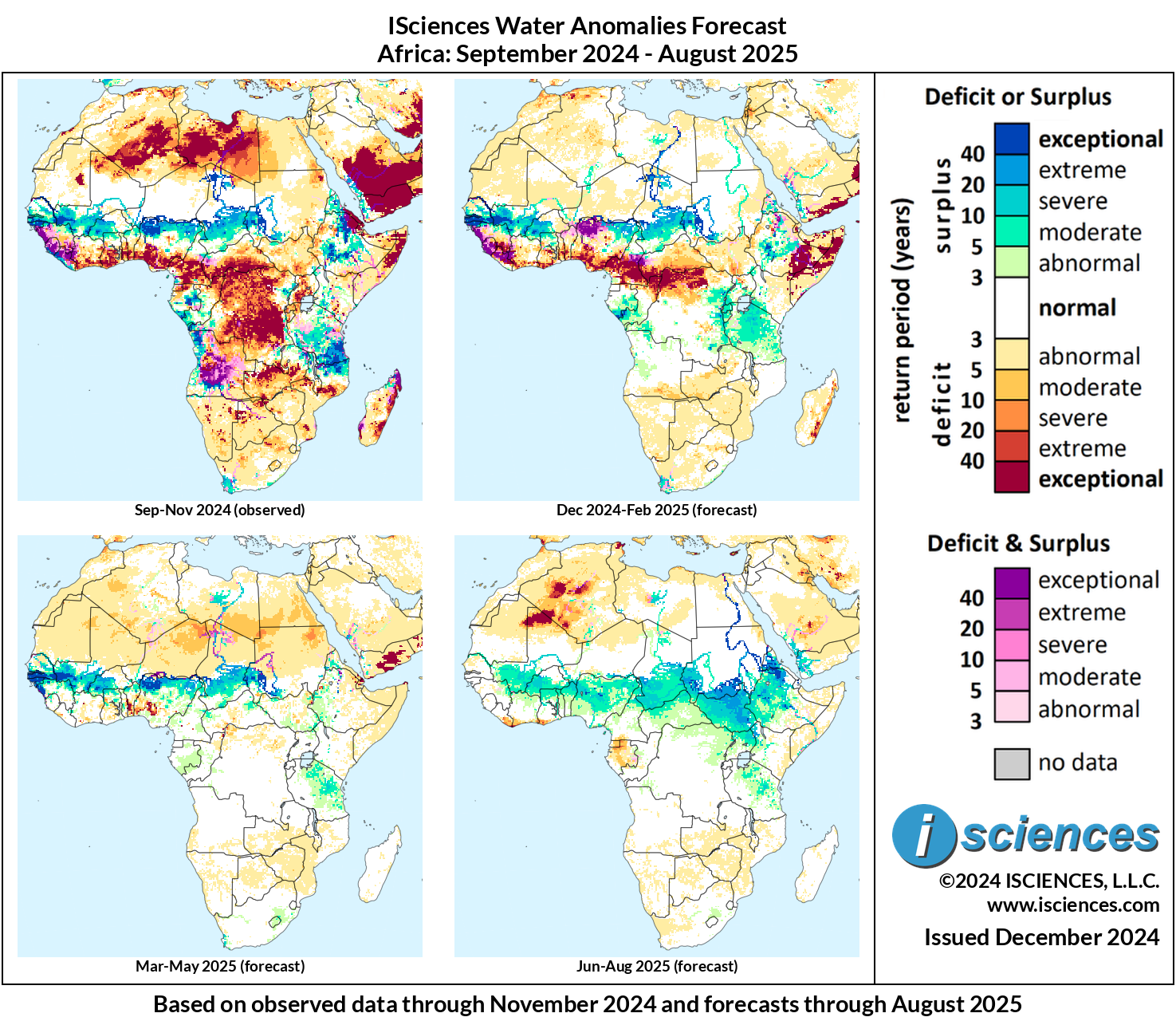Africa: Surplus to continue along the sahel
23 December 2024
THE BIG PICTURE
The forecast for the 12-month period ending in August 2025 indicates that exceptional deficits will mostly resolve in northern, southern, and central countries, but will persist in the Horn of Africa. Surpluses along the Sahel are expected to remain.
Extreme to exceptional deficits are expected in:
Northeastern Mauritania’s Ouadane region and northern Mali, primarily within the Salam region. These deficits continue into southwestern to eastern Algeria and isolated regions of western, central, and eastern Libya.
The coastal regions of Morocco and the disputed territory of Western Sahara.
The Horn of Africa, primarily in Djibouti, northern Somalia, and in eastern areas of Ethiopia’s Somali region.
Southeastern Democratic Republic of Congo, near the Haut-Lomami province.
Regions along the borders of eastern Botswana, southwestern Zimbabwe, and southwestern Mozambique. Further east, north-central Madagascar, as well as eastern coastal regions, can expect extreme to exceptional deficits.
Severe to exceptional surpluses are anticipated in:
Southern Senegal and throughout Guinea-Bissau, continuing into most of southern and western Mali.
Areas along the borders of southern Niger and northern Nigeria.
Northwestern and southern Chad, throughout the rivers in the Tibesti region and spanning near the city of N’Djamena into the Salamat region. These surpluses continue into the majority of southwestern Sudan and also occur in central to northern Ethiopia.
South-central Gabon, as well as in areas along the border of southern Gabon and southwestern Republic of Congo.
The 3-month maps (below) show the evolving conditions in more detail.
FORECAST BREAKDOWN
The forecast through February 2025 indicates that surpluses along the Sahel will persist, though some transitional conditions are expected to arise in coastal regions of Guinea, Sierra Leone, and central Liberia. Transitional conditions are also expected in southwestern areas of Niger and northwestern Nigeria. Exceptional deficits are expected to span across most southern coastal regions of the Ivory Coast, Ghana, Nigeria, and into much of central to southern Cameroon, southwestern Central African Republic, northern Republic of Congo, and northwestern Democratic Republic of Congo. Southwestern Ethiopia and northern to eastern Somalia will observe exceptional deficits. West-central Ethiopia is expected to observe mostly moderate surpluses, with some extreme to exceptional surpluses lingering in the northern areas of the Tigray region.
From March through May 2025, severe to exceptional surpluses will continue in the Sahel, spanning from Guinea-Bissou, western to southern Mali, and into regions along the southern border of Niger and northern border of Nigeria. These surpluses continue into central to southern Chad and southwestern Sudan. Some deficits of severe to exceptional intensity may persist in southern Benin and south-central Nigeria.
The forecast for the final months – June through August 2025 – indicates that surpluses may remain throughout the Sahel, as well as in countries further south, including South Sudan and Uganda.
Please note that WSIM forecast skill declines with longer lead times.
IMPACTS
The 2023/24 El Niño weather event caused the worst one of the dry spells in southern and eastern Africa in more than 100 years, as well as the lowest mid-season rainfall in more than 40 years. In southern Africa, nearly 29 million people dealt with food insecurity due to drought. In eastern Africa, heavy rains destroyed buildings and infrastructure, displacing thousands in Ethiopia, Kenya, and Somalia.
President Joe Biden announced over $1 billion in aid for 31 African countries currently dealing with food scarcity and displacement by drought or conflict. The funds will primarily assist refugees, displaced persons, and populations specifically vulnerable to food insecurity. According to USAID, the U.S. has already provided nearly $6.6 billion in humanitarian aid to sub-Saharan Africa in the 2024 fiscal year. According to the UN, nearly 300 million Africans faced hunger in 2023, with food insecurity worsening.
South Africa's economy saw an unexpected decline in the third quarter of 2024, primarily due to a severe drought that caused a 28.8% drop in agricultural production, particularly affecting soy crops and maize. "Maize and soy account for about 70% of field crops and we know they have had a difficult quarter due to drought," stated statistician Joe de Beer.
NOTE ON ADMINISTRATIVE BOUNDARIES
There are numerous regions around the world where country borders are contested. ISciences depicts country boundaries on these maps solely to provide some geographic context. The boundaries are nominal, not legal, descriptions of each entity. The use of these boundaries does not imply any judgement on the legal status of any territory, or any endorsement or acceptance of disputed boundaries on the part of ISciences or our data providers.
Subscribe to our monthly Water Watch List
Search blog categories
- *Precip/Temp Outlooks 101
- *Press Releases 1
- *Special Topics 21
- *Water Watch Lists 121
- Africa 130
- Australia & New Zealand 114
- Canada 116
- Central Asia & Russia 114
- East Asia 115
- Europe 121
- Impact Highlights 1
- Mexico & C. Amer. & Carib 119
- Middle East 124
- Proof Point 2
- South America 130
- South Asia 120
- Southeast Asia & Pacific 123
- United States 120
Search blog tags


